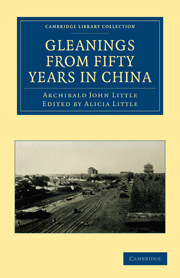Book contents
THE CHINESE DRAMA
Published online by Cambridge University Press: 10 November 2010
Summary
According to the Shu-King or Book of History edited by Confucius, the Chinese practised music from the earliest times, as far back as 2200 B.C. The Emperor Shun, the founder of the second great dynasty of Hsia in China's Golden Age, is reported to have had a master of music and ceremonies. Their religious worship was always accompanied by music and dancing, which last might more fitly be called posturing, like that which we see to-day in the Shinto temples in Japan. These old dances, we are told, exhibited the occupations of the people of those times, and, after the symmetrical fashion of the Chinese, are described as having represented the four occupations of ploughing, harvesting, war, and peace, and the four corresponding sensations of work, joy, fatigue, and content. The Shu-King covers a period of seventeen centuries from 2400 B.C. to 720 B.C. We are there told that the performers carried shields representing war, hoes for agriculture, and flags for victory, while sacrificing to the mountains, rivers, and earth. A later Chinese treatise describes these pantomimes more in detail. The dancers entered from the north and displayed in their positions and gestures an order of battle. Thence the dancers advanced to the south, and formed up in line, while the leaders represented the celebrated Chow-Kung and Chao-Kung, the advisers of Wen-wang, the literary prince and son of Wu-wang, the military prince who destroyed the corrupt dynasty of Hsia, and founded that of Chow, under which flourished the three great sages of China, Confucius, Mencius, and Lao-tse.
- Type
- Chapter
- Information
- Gleanings from Fifty Years in China , pp. 216 - 224Publisher: Cambridge University PressPrint publication year: 2010First published in: 1910

